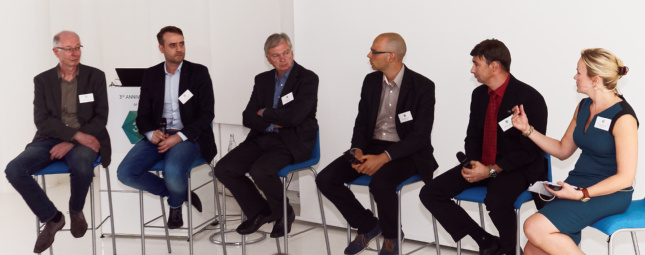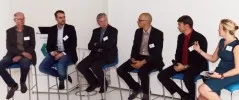After the introductions, there were a number of panel sessions. The first was on the subject of the 3DInMed medical project which looked at topics including the capture and transmission of 3D content for endoscopy and microscopy. The project has won financial support to back the project and started fully in July. HHI has a lot of technology for depth capture, developed over decades. For example, in endoscopy, the sensors may have limitations in showing clear depth in images, because of the small optics and closeness of the subject matter. Technology may make depth more obvious.
The first panel was made up of Christoph Grossmann of SeeFront, Benedikt Appold of Solectrix, Sebastien Weitbruch of iiMotion, and Matthias Kuehn of Schölly Fiberoptic. Schröter moderated the panels.

Appold said that there are many people involved in how technology can be used including doctors, nurses and technologists – the nurses are important as they observe how the surgeon works.
All the companies in the project are small to medium and for the smaller ones, the project is a significant one. iiMotion is working on the image sensors and cameras for the endoscopes to send good quality images to the other partners. Schölly is involved in fibreoptics, so it is working on the delivery of the video data from the camera and to the main PC. Solectrix is developing camera modules for industrial (4mm lens) and other (6mm lens) applications. SeeFront makes autostereoscopic 3D monitors for single viewers, using eye tracking to optimise the image. (People wearing surgical masks can be harder to track and wouldn’t wear 3D glasses!)
Latency is a key issue – the surgeon has to feel as though there is no delay and that the images are “live”. Responding to a question, Appold of Solectrix said that at the moment, 0.9mm is the smallest sensor, but in the future new technologies using scanning fibres can be smaller. However, going smaller makes depth sensing more tricky and tends to reduce optical efficiency, so you need more light and that can be a challenge. Electronic techniques can be used to increase the apparent depth of the image.
For medical applications, you need a lot of accuracy and quality, as you can’t make the kind of software corrections and distortions that you can use in smartphones to improve apparent quality.
Weitbruch of iiMotion said that glasses are not popular for stereo viewing, but they are still the main technology for stereo viewing. Surgeons want to see a lot of depth of field in the image.
The outcome of the project is hoped to be the development of three better systems, one for microscopy, one for endoscopy and another for building panoramas (e.g. of the travel of an endoscope through a human system). In Erlangen, tests of the system so far developed by cancer specialists, showed that the detection of lesions that are the pre-cursors of tumours in bowel cancer. Schaefer said that the surgeons are driving this project to promote practical results and are very enthusiastic.

